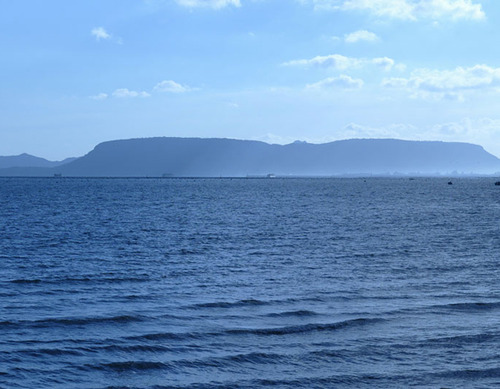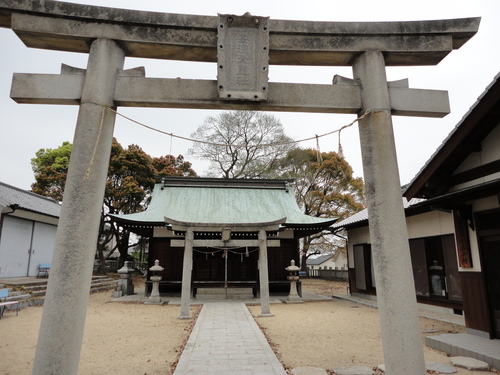2011年08月11日
Historic Yashima
Although Yashima today is a tranquil oasis in the middle of the city, in the 12th century it was the site of a key battle in the Genpei War (1180-1185).

Yashima from the sea
This war was the final stage of a complicated power struggle involving two rival clans, the Genji (Minamoto) and the Heike (Taira). The result was a shift in control from the emperor and aristocracy to the samurai class, a shift that lasted until the mid-19th century. Or even longer really, if you consider the fact that the military continued to control the government until the end of World War II.
(For more about the Genpei War, check here:http://en.wikipedia.org/wiki/Genpei_War .)
Legends surrounding the Battle of Yashima have been passed down through the centuries in classical literature, epic musical narratives, Noh and Kabuki. Even after nine centuries, many stories are still part of local Kagawa folklore, demonstrating the impact of this conflict on the Japanese psyche. In early April, I spent two fun afternoons reliving these tales with Yashima's very friendly and capable volunteer guides. Although some of the details may be more legend than fact, they make for great stories. Here is some of what I learned.

Looking east at dawn from Yashima towards the former battle ground.
By the time the battle of Yashima took place, the Heike clan and their boy emperor Antoku were on the retreat and had settled temporarily on the east side of Yashima. Emperor Antoku's 'palace' (since replaced by a shrine) was a very modest structure because they were on the move and still hoping to regain ascendancy.


Expecting an invasion from the sea, the Heike fort faced toward Osaka on the island of Honshu and their fleet of ships was hidden in a cove to surprise the enemy. It was they, however, who were surprised.

Cove where the Heike hid their ships across from Yashima
As the legend goes, in early 1185, the young Genji general, Yoshitsune, crossed over to Shikoku under cover of a raging gale and landed about 40 miles east of the Heike fort. Whereas the Heike are estimated to have had between 1,000 and 3,000 horsemen, Yoshitsune had only 150 or so horsemen. With help from some local warriors, the Genji force quickly covered the distance over land to Takamatsu, arriving in the rear of the Heike garrison.
Below is the spot where Yoshitsune and his men rested once they reached Takamatsu, indicating how this story has been kept alive in local memory.

The Heike were garrisoned on the island of Yashima, which was difficult to attack from land. Yoshitsune, however, discovered that the water was shallow enough for cows to cross in one spot. He ordered some of his men to ford the channel and attack the Heike from the rear.

The spot where they forded the channel.
At the same time, Yoshitsune and his men shot burning arrows into the pine trees around the local village. Home to several thousand people, this settlement had sprung up near the fort to feed and service the Heike. The trees burst into flame, destroying the village and driving hoards of migrating birds into the air. According to my guides, the battlefield encompassed everything on the east side of the ridge all the way over to the next bay and settlements on both sides of the channel in this photo were torched, with the fires stretching up the far hill.

Former battlefield
I can't help thinking how hard that must have been on the poor local people! This tactic, however, worked. Seeing the fires and the birds, the Heike assumed they were being invaded by a massive army and fled to their ships. The brunt of the Genji forces attacked the fleeing Heike in the shallows while a few others set fire to the deserted Heike fort.
To be continued!!

Yashima from the sea
This war was the final stage of a complicated power struggle involving two rival clans, the Genji (Minamoto) and the Heike (Taira). The result was a shift in control from the emperor and aristocracy to the samurai class, a shift that lasted until the mid-19th century. Or even longer really, if you consider the fact that the military continued to control the government until the end of World War II.
(For more about the Genpei War, check here:http://en.wikipedia.org/wiki/Genpei_War .)
Legends surrounding the Battle of Yashima have been passed down through the centuries in classical literature, epic musical narratives, Noh and Kabuki. Even after nine centuries, many stories are still part of local Kagawa folklore, demonstrating the impact of this conflict on the Japanese psyche. In early April, I spent two fun afternoons reliving these tales with Yashima's very friendly and capable volunteer guides. Although some of the details may be more legend than fact, they make for great stories. Here is some of what I learned.
Looking east at dawn from Yashima towards the former battle ground.
By the time the battle of Yashima took place, the Heike clan and their boy emperor Antoku were on the retreat and had settled temporarily on the east side of Yashima. Emperor Antoku's 'palace' (since replaced by a shrine) was a very modest structure because they were on the move and still hoping to regain ascendancy.
Expecting an invasion from the sea, the Heike fort faced toward Osaka on the island of Honshu and their fleet of ships was hidden in a cove to surprise the enemy. It was they, however, who were surprised.
Cove where the Heike hid their ships across from Yashima
As the legend goes, in early 1185, the young Genji general, Yoshitsune, crossed over to Shikoku under cover of a raging gale and landed about 40 miles east of the Heike fort. Whereas the Heike are estimated to have had between 1,000 and 3,000 horsemen, Yoshitsune had only 150 or so horsemen. With help from some local warriors, the Genji force quickly covered the distance over land to Takamatsu, arriving in the rear of the Heike garrison.
Below is the spot where Yoshitsune and his men rested once they reached Takamatsu, indicating how this story has been kept alive in local memory.
The Heike were garrisoned on the island of Yashima, which was difficult to attack from land. Yoshitsune, however, discovered that the water was shallow enough for cows to cross in one spot. He ordered some of his men to ford the channel and attack the Heike from the rear.
The spot where they forded the channel.
At the same time, Yoshitsune and his men shot burning arrows into the pine trees around the local village. Home to several thousand people, this settlement had sprung up near the fort to feed and service the Heike. The trees burst into flame, destroying the village and driving hoards of migrating birds into the air. According to my guides, the battlefield encompassed everything on the east side of the ridge all the way over to the next bay and settlements on both sides of the channel in this photo were torched, with the fires stretching up the far hill.
Former battlefield
I can't help thinking how hard that must have been on the poor local people! This tactic, however, worked. Seeing the fires and the birds, the Heike assumed they were being invaded by a massive army and fled to their ships. The brunt of the Genji forces attacked the fleeing Heike in the shallows while a few others set fire to the deserted Heike fort.
To be continued!!



